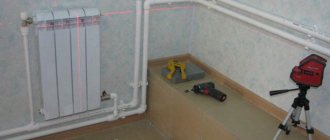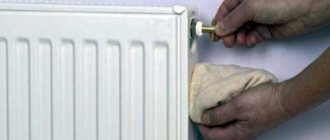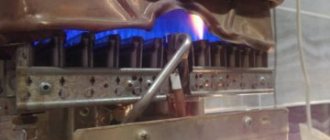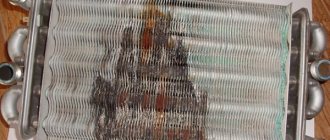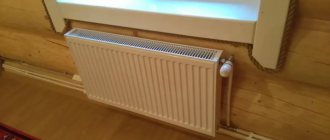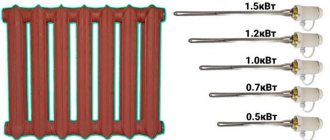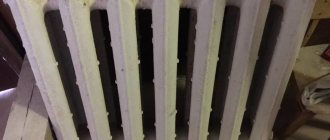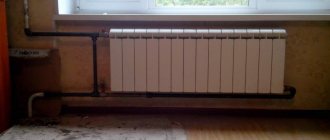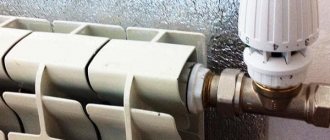Heating cannot be classified as the simplest device. Its work is based on various physical laws; the system uses devices and mechanisms of various functional purposes, and to obtain the desired result it is necessary to ensure their coordination with each other. One of the features of water heating is an effect called water hammer in the heating system - a sharp, albeit short-term, increase in pressure in the system.
Abrupt manipulations with shut-off valves - opening or closing - lead to an instant change in pressure in the device area. When closing, the pressure on the valve and its connecting elements increases. In this case, seals of threaded connections, wafer gaskets, and, at high pressure, elements of the shut-off device are often damaged. When opening quickly, there is a low pressure area in the area behind the valve. The liquid instantly rushes into it, acquiring greater speed. In this case, elements located after the reinforcement are subject to destruction. Areas with high hydraulic resistance are especially susceptible to water hammer - bends in pipelines, heating devices (radiators, convectors, etc.).
How to open and close the battery correctly? In what order?
Water hammer occurs when steam enters water. Since dangerous steam heating has not been used in residential premises for a long time, I dare say that you have nothing to fear. However, in any case, it is wiser to first shut off the flow of water into the battery, and only then its exit from the battery. Well, there is no point in keeping high pressure in your own battery, the integrity of which depends precisely on the pressure.
How to open and close the battery correctly? In what order?
Heating cannot be classified as the simplest device.
Its work is based on various physical laws; the system uses devices and mechanisms of various functional purposes, and to obtain the desired result it is necessary to ensure their coordination with each other. One of the features of water heating is an effect called water hammer in the heating system - a sharp, albeit short-term, increase in pressure in the system. Abrupt manipulations with shut-off valves - opening or closing - lead to an instant change in pressure in the device area. When closing, the pressure on the valve and its connecting elements increases. In this case, seals of threaded connections, wafer gaskets, and, at high pressure, elements of the shut-off device are often damaged. When opening quickly, there is a low pressure area in the area behind the valve. The liquid instantly rushes into it, acquiring greater speed. In this case, elements located after the reinforcement are subject to destruction. Areas with high hydraulic resistance are especially susceptible to water hammer - bends in pipelines, heating devices (radiators, convectors, etc.).
How to open and close the battery correctly? In what order?
Water hammer occurs when steam enters water. Since dangerous steam heating has not been used in residential premises for a long time, I dare say that you have nothing to fear. However, in any case, it is wiser to first shut off the flow of water into the battery, and only then its exit from the battery. Well, there is no point in keeping high pressure in your own battery, the integrity of which depends precisely on the pressure.
Very important information
Below we will describe situations when one or another inclusion of the battery may be undesirable, and sometimes unacceptable!
By reading my blog, you are probably making repairs.
this page to your bookmarks . This is where all the useful home improvement stores are located.
| Not every plumbing store sells heating regulators. Here is a fairly powerful catalog with a large selection of thermostats, which can be filtered by price and manufacturer. |
4.1.You cannot use the thermostat without a jumper
In point 2 we talked about the thermostat. However, you need to understand that experiments with a temperature controller are only possible with a jumper! If it is not there, and you reduce the diameter of the flow pipe, then the total flow of hot water through your apartment will decrease. Which of course is unacceptable, otherwise your neighbors will come to you!
4.2. The thermostat may become clogged
If you are using a jumper, but for some reason it was turned off for a while and the thermostat was set to position 5, i.e. provided a full flow of hot water only through the battery, as shown in the figure:
then everything seems to be fine. However, we must accept reality as it is. Even if we turned on the central heating radiators correctly for the first time, there is no guarantee that, for example, in a month or two a new mud flow will not pass through the pipes. But then, if the jumper is turned off, then the splash of dirt will go straight to your thermostat, which, in fact, is very sensitive to it. As a result, a blockage forms in the thermostat, and water will not flow into the battery at all. It won’t go into the jumper either, because you closed it. Therefore, in this situation, water will stop flowing through your apartment; in the house, through your heating riser, the water will also stop and begin to cool in the cold. As a result, a squad of evil neighbors, together with the chairman of the HOA or housing cooperative, is guaranteed to enter your apartment.
It is clear that switching on according to the above figure is similarly not acceptable for the regulator positions 4,3,2,1,*
4.3. The jumper must always be on
Make it a rule that it doesn’t matter whether you use a temperature controller or not, but the jumper should always be on. This way, you will always ensure hot water flow through your apartment. When does it make sense to turn off the jumper? For example, when you feel that the battery is clogged. Then you let all the water flow through the battery by disconnecting the jumper. Perhaps a more powerful stream of hot water will be able to push through the stuck dirt. But this needs to be done for a short time and only under your control - you cannot leave the situation like this and go to sleep. The fact is that if the dirt cannot be pushed through, then a congestion will form again: water will not be able to pass through either the battery or the jumper.
4.4. During installation, the thermostat must be installed behind the jumper, i.e. directly in front of the battery
This is mega important, because if it is installed before the jumper, then when you first turn it on, dirt will definitely clog your thermostat, and you will start the heating season with a complete rewiring of the battery:
4.5. Avoid outright carelessness when installing ball valves in different positions
This installation of ball valves in your system will again ensure that your neighbors come to you:
You just completely turned off the water :).
Well, that's all, dear readers! I tried to tell you in as much detail as possible about the nuances of operating heating batteries!
Have you ever accidentally blocked the heating pipe in your house?
Is it possible to leave the heating system without water in the summer?
Do not completely block the flow of water to the radiator. Turning off the radiator is possible only during the period of pressure testing (a set of works to identify faults) of the heating system.
Do not leave a heating system with aluminum radiators without water for more than 15 days a year.
In what position should the supply valves be located?
With regard to supply taps, it would be correct to do this: close the bottom tap, open the top tap. With this position of the taps, the presence of water in the battery throughout the entire period: spring - summer - autumn - winter will be ensured, there will be no threat of vacuum formation and everything will be fine with the battery.
What will happen if you don’t turn off the taps?
When the hot water supply starts and stops, all the rust flows through the pipes. If the taps are not turned off, very dirty water will pass through the battery and the battery may become clogged. However, if for some reason both supply taps must remain in the “closed” position, be sure to open (unscrew) the Mayevsky tap. Otherwise, the radiator may rupture due to a chemical reaction between the additives contained in the coolant and aluminum. Please note that if the radiator ruptures, this will not be a warranty case!
What if you turn off both taps?
As the water begins to cool, its volume in the battery will begin to decrease. This will cause a vacuum to form there. Why is he so scary? Your battery will experience severe pressure once a vacuum begins to form inside it. It will either become deformed or crack. To avoid this, after the end of the heating season, you should never turn off both taps!
What to do when a new heating season approaches?
After you have learned that the heating will be turned on the next day, remember that at the moment the water is supplied, the rustiest water will flow through the pipes. To avoid clogging the battery, turn off both taps! The jumper (bypass) must be open at this time!
When hot water is supplied, it will flow through the bypass. We advise you not to turn on the battery for the first couple of days. Let all the rust pass by your radiators!
From the bypass, the water in the battery will begin to heat up slightly, which will lead to an increase in pressure inside the battery, but this should not scare you. A slight increase in pressure cannot lead to deformation of the radiator.
1-2 days after supplying hot water through the jumper, open both taps on the battery.
That's it, you and your heating system are ready for winter!
After installing brand new heating radiators for a considerable amount of money, many people want to extend their service life and not lose heat transfer, or prevent them from becoming clogged with dirt. New radiators, unlike old cast-iron radiators, have shut-off valves that can be closed. The question immediately arises: should we block it or not?
To answer this question, it is advisable to find out whether your housing office is bona fide or not. Namely, whether it keeps the system filled with water when the heating is turned off or not.
The fact is that the main enemy of metal is corrosion. It manifests itself to a lesser extent when the system is dry or when it is completely filled with water, without air access. The fertile environment for destruction is moisture and oxygen. According to standards, the system should always be filled with water, but many management companies ignore this. Firstly, during repairs, the system has to be drained and then refilled, wasting time. Secondly, water is now metering devices and real money. If over the summer 10 people in a house decide to change or repair the batteries, the system will have to be drained and filled 10 times, and it’s good if you can drain individual risers and not the whole house at once, as, for example, I have. This is where some companies sin by not filling the tubes with water at all in the summer. Naturally, a closed system cannot dry out and moisture remains there. As already mentioned, air and moisture are excellent catalysts for corrosion.
Therefore, if your management company is not conscientious, it is better to close the cut-off valves on the eve of the end of the heating season. This can be done if, with the radiators closed, the coolant can flow bypassing them (along the riser or through a jumper). More on this below. Additionally, open the air bleed valve - to get rid of excess pressure that arises from a temperature difference or during a chemical reaction of the metal with the coolant, if the quality of this very metal and (or) coolant is not very good. The main thing is this tap, correctly it is called the Mayevsky tap, then don’t forget to close it.
You can check whether a company is bona fide or not several times during the summer. To do this, open the top valve and the air bleed valve. If water or first air then water presses through the faucet, there is water in the system. At the same time, the bottom valve, which remains closed, will not allow water to escape from your radiator if the system is not full.
The question logically arises: why check anything at all? It's better to block everything. It turns out not always.
Radiator with jumper
If you have a jumper next to the radiator, you can close the shut-off valves and not have to monitor whether there is water in the system or not.
Radiator without jumper and riser
If all the coolant flows through the battery and there is no jumper, the batteries should never be shut off.
Radiator without jumper with riser
If the riser goes through your apartment, and there are no jumpers near the radiators, then with the shut-off valves closed and a conscientious company filling the system with water for the summer, air pockets may form in your pipes, from the riser to the battery. The same air and moisture. Therefore, if the management company is in the habit of keeping the system filled with water, the shut-off valves can be kept open. This can help avoid air pockets when filling.
As for closing radiators or not while flushing the heating system, if the radiators are new and have been used for the first 1-2 years, close them. It will drag in more dirt than it will wash off. Ideally, they should be opened a day after turning on the heating in the house, after the main dirt has gone away. Once every 1-2 years, it is advisable to remove the radiators and wash them yourself with hot water. Close attention to each radiator is clearly better than a general system flush. Fortunately, these are not cast iron batteries. They are removable perfectly, and you can wash them with a shower hose, twisting the watering can off it and removing the gasket so that it does not get inside.
Before removing, do not forget to close the shutoffs and lay a rag on the floor, or better yet, a thick film and a rag on top. Radiators may leak a natural black slurry that will be difficult to clean off the floor. They should also be placed in the bathroom. To protect against damage and heavy dirt. In general, the question of whether or not to shut off batteries should be guided by logic: - Heating radiators (batteries) must be constantly filled with water. — There is no need to expose them to excess pressure, which can occur if they are closed tightly. This means you need to leave the upper shut-off valve open while the lower one is closed, or close both shut-off valves and open the Mayevsky valve. Provided that your blocked battery does not disrupt the circulation throughout the riser. This is written above.
The question of whether or not to cover bimetallic radiators in the summer is similar to the question of whether or not to cover aluminum ones in the summer. The above is true for both types. The difference between them is that bimetallic radiators can withstand greater pressure and are less likely to release gas when the metal interacts with the coolant. Despite this, the rules must be followed for them as well.
Good afternoon, dear readers! Today I will continue the topic of central heating batteries. We will talk to you about the operation of heating batteries. Almost everyone needs this topic, and my task is to help you understand this issue once and for all. So, I hope you have already read my article: Correct installation of a central heating battery in an apartment. We will assume that the battery has been installed for you. What's next?
In what order should the taps (valves) in the batteries be opened and closed?
There are two taps on the battery. They say that if you close them in the wrong order, you may experience water hammer.
For heat to enter, it is first necessary to bleed air from the radiator, so first we open the Mayevsky valve (bleeder) and make room for further steam (water) to enter.
As soon as the air is released, open the main valve (at the inlet) and wait for the batteries to start warming up. Water hammer is a real phenomenon, but it happens extremely rarely in apartments, so to avoid an accident you must follow simple instructions.
- When starting the heating radiator, you first need to bleed the air from the battery.
- Therefore, first we open the air valve, then the tap to open.
- Once water flows from the battery through the air valve, this will mean that the air has been released.
- We open both taps fully, the system will start working (water will circulate).
Source
The need to adjust heat transfer
There are two reasons why heating radiators need to be adjusted:
- Reducing home heating costs. True, in an apartment located in a multi-storey building, it is possible to reduce the amount of payments only if there is a common building heat meter. In a private household, if an automated boiler is installed, installation of regulators is unlikely to be required. The amount of savings will be significant.
- There is a need to maintain the desired temperature in the premises. For example, in one room it may be 17 degrees Celsius, and in another – 25 degrees. To do this, you need to set the appropriate numbers on the thermal head or close the valve.
List of situations when this is necessary
Even in the absence of any natural disasters or serious problems, there are many situations when it is imperative to turn off the heating radiator.
Here are the most relevant ones:
- daylight saving time;
- inspection before the opening of the heating season;
- replacement and repair of radiators;
- emergency situation;
- if the room is too hot.
Adjusting heating radiators
To understand the question of how to regulate heating batteries with a regulator, first of all, you should find out the principle of their operation. By design, the radiator consists of a labyrinth of pipes and fins of various types, which provide increased heat transfer.
Hot liquid enters the device, passes through the labyrinth and thereby heats the metal, which gives off heat to the surrounding air. The fins on modern radiators are made of a special shape, which improves the convection of air flows, and the room is heated quickly.
In the case of active heating from the batteries, a heat flow is felt. This means that when you change the amount of coolant passing through the device, you can adjust the room heating temperature, albeit within certain limits.
This is what special fittings are designed for - thermostats and valves. But a heating regulator installed on a radiator in an apartment is not capable of increasing heat transfer; it can only reduce it.
The effectiveness of changing battery temperature depends on:
- on whether the heating devices have power reserves;
- from the correct selection and installation of regulators.
Of no small importance is the inertia of the entire heating system and the batteries themselves. For example, cast iron, which has a large mass, changes temperature slowly, while aluminum heats up quickly and cools down the same way. This means that there is no point in having cast iron radiators with temperature control, since it takes a long time to get results.
Installation
In heating systems of residential buildings, where pipes of small diameters are mainly used, taps are installed on radiators using threaded connections. The most convenient type of connection is recognized as colloquially called “American”. The fitting part is equipped with one or two union nuts, each of which covers the connecting shank and can rotate freely around it. The nut is screwed onto the pipe, pressing the tap against it, while the end of the pipe rests against the gasket installed inside the tap. Installation of fittings on an “American” connection is simpler than on a coupling connection, and the valve can be located quite close to the wall.
American crane.
In order to disassemble the connection, it is enough to unscrew the nut on one side. This allows, for example, to dismantle heating radiators for repairs or access to a section of the wall located behind them without disconnecting the entire riser. Replacing faucets on an American model, as well as installation, requires minimal effort. Most “American” ones have a hexagon shape; their installation on batteries is done using a regular wrench. But in some models the nut is equipped with two protrusions, for which a special key is provided. The first option is undoubtedly more convenient, since wrenches are used quite often in the household, and therefore are always at hand.
When installing the valve for the heating radiator for the first time, all threaded connections are assembled without sealing. In this way, they find out whether the parts fit together well and how freely they move. Knowing this, you can determine the amount of sealing material that will be needed for a given threaded connection. A lack of seal will lead to a leak, but its excess is even more undesirable: while tightening, the nut may burst, the only way out in this case is to replace the entire part.
Ways to increase the heat transfer of batteries
The presence/absence of the opportunity to increase heat transfer depends on the calculation of the radiator power reserve. If the device is not able to produce more thermal energy, then no fittings will help.
You can try to change the situation in one of the following ways:
- First of all, you should check whether the filters and pipes are clogged. Blockages form both in old buildings and in new buildings, as various construction debris enters the system. When cleaning does not produce results, drastic measures need to be taken.
- Increase in coolant temperature. This can be done if there is an autonomous heating supply, but with centralized heating it is unlikely.
- Changing the connection type. Not all battery connection methods are equally effective. For example, a reverse side connection reduces power by about a quarter. The location of installation of the device also affects the heat transfer.
- Increasing the number of sections. If the location and method of connecting radiators are chosen correctly, and the room is also cold, this means that the thermal power of the devices is not enough. Then it is necessary to increase the number of sections.
If the heating system is equipped with batteries with temperature control, then they require a certain power reserve and this is their main drawback. As a result, heating installation costs increase, since each section costs money.
Comfort cannot be achieved if the room is cold or too hot, so adjusting the heat in radiators is a universal solution to this problem.
There are many devices on sale that are designed to change the volume of coolant passing through the radiator. Among them there are both inexpensive and high-cost products. They come with different adjustments: manual, electronic and automatic.
Very important information
Below we will describe situations when one or another inclusion of the battery may be undesirable, and sometimes unacceptable!
By reading my blog, you are probably making repairs.
this page to your bookmarks . This is where all the useful home improvement stores are located.
| Not every plumbing store sells heating regulators. Here is a fairly powerful catalog with a large selection of thermostats, which can be filtered by price and manufacturer. |
4.1.You cannot use the thermostat without a jumper
In point 2 we talked about the thermostat. However, you need to understand that experiments with a temperature controller are only possible with a jumper! If it is not there, and you reduce the diameter of the flow pipe, then the total flow of hot water through your apartment will decrease. Which of course is unacceptable, otherwise your neighbors will come to you!
4.2. The thermostat may become clogged
If you are using a jumper, but for some reason it was turned off for a while and the thermostat was set to position 5, i.e. provided a full flow of hot water only through the battery, as shown in the figure:
then everything seems to be fine. However, we must accept reality as it is. Even if we turned on the central heating radiators correctly for the first time, there is no guarantee that, for example, in a month or two a new mud flow will not pass through the pipes. But then, if the jumper is turned off, then the splash of dirt will go straight to your thermostat, which, in fact, is very sensitive to it. As a result, a blockage forms in the thermostat, and water will not flow into the battery at all. It won’t go into the jumper either, because you closed it. Therefore, in this situation, water will stop flowing through your apartment; in the house, through your heating riser, the water will also stop and begin to cool in the cold. As a result, a squad of evil neighbors, together with the chairman of the HOA or housing cooperative, is guaranteed to enter your apartment.
It is clear that switching on according to the above figure is similarly not acceptable for the regulator positions 4,3,2,1,*
4.3. The jumper must always be on
Make it a rule that it doesn’t matter whether you use a temperature controller or not, but the jumper should always be on. This way, you will always ensure hot water flow through your apartment. When does it make sense to turn off the jumper? For example, when you feel that the battery is clogged. Then you let all the water flow through the battery by disconnecting the jumper. Perhaps a more powerful stream of hot water will be able to push through the stuck dirt. But this needs to be done for a short time and only under your control - you cannot leave the situation like this and go to sleep. The fact is that if the dirt cannot be pushed through, then a congestion will form again: water will not be able to pass through either the battery or the jumper.
4.4. During installation, the thermostat must be installed behind the jumper, i.e. directly in front of the battery
This is mega important, because if it is installed before the jumper, then when you first turn it on, dirt will definitely clog your thermostat, and you will start the heating season with a complete rewiring of the battery:
Ball Valves
Valves are cheap, but at the same time ineffective control devices. Ball valves are often installed at the entrance to the radiator, with the help of which they regulate the flow of water.
But this equipment also has another functionality - shut-off valves. Valves are used to completely shut off the flow of coolant into the system. For example, in the event of a leak in a heating device, ball valves located at the inlet and outlet of the radiator allow repairs to be made without stopping the heat supply and draining the liquid.
Heating radiators in the apartment cannot be adjusted using ball valves. They have only two positions - completely closed and open. An intermediate position only brings harm.
The fact is that inside such a faucet there is a ball with a hole, which in its normal position is not in danger, but in all other situations the solid particles present in the coolant grind it down and pieces break off from it. As a result, the tap will not be sealed and in the “closed” position, water will continue to flow into the battery, which can lead to big troubles if the device leaks.
Is it worth turning off heating appliances?
Attention! Ball valves cannot be used to regulate the flow of coolant if you want to reduce the heating of the batteries! This valve is a shut-off valve; its use for other purposes leads to destruction of the valve and leaks.
Based on the above, if there is no bypass, but ball valves are installed, the battery can be dismantled independently for repair or replacement, but not during the heating season.
Heater with installed bypass
The bypass (jumper) is mounted parallel to the radiator and is usually a pipe whose diameter is equal to the diameter of the supply pipes or one step smaller. If you plan to shut off the radiators after the heating season or install a radiator with a thermostat, be sure to take care of installing a bypass. Otherwise, your actions will lower the temperature of the coolant and your neighbors.
Needle valve
This device is usually installed in the heating system in front of the pressure gauge. The valve smoothly and effectively changes the flow of coolant, gradually blocking it. The design feature of this device is that the width of the passage in it is half as much.
For example, when installing inch pipes and the same cross-section of a needle valve, its capacity will be only ½ inch. As a result, each device built into the system reduces this parameter. Several products installed in series, for example in a single-pipe design, result in the latter devices being lukewarm or cold.
Since the passage is greatly narrowed, a needle device is not recommended to be installed when solving the problem of how to regulate the temperature of the battery, since its heat transfer is greatly reduced.
You can increase it as follows:
- removing the valve;
- doubling the number of sections;
- by installing a device that has twice as many couplings.
Why is the water not drained at the end of the heating season?
As you know, water remains in heating networks even in summer. This is explained by the fact that in this way corrosion processes inside radiators and pipelines are reduced. And it is water that will help prevent corrosion, since in this case steel and cast iron will be much less susceptible to rust. No matter how paradoxical it may sound, it really is so. For what reasons does this happen? Everything is quite simple: (See also: How to disassemble a cast iron heating radiator with your own hands)
- Water is constantly inside the heating system and does not allow metal to come into contact with air. Corrosion occurs when a metal comes into contact with dissolved oxygen in water;
- Due to the isolation of the heating system from the outside world, the water is quickly deprived of dissolved oxygen. Then the oxidation process, which is usually a catalyst for corrosion processes, is completely eliminated.
- As a result of all this, the heating network does not rust at all from the inside, which cannot be said about the cold and hot water pipeline system. However, if water is removed from the system, moist air with a high oxygen content will remain. This is precisely why pipes and radiators rust from the inside in the absence of coolant. (See also: How to calculate bimetallic heating radiators)
Before turning off the radiator, you need to study the other side. According to established standards, the heating network must always contain water. At the same time, some management organizations often neglect this requirement in order to save money. Thus, during repairs, it is necessary to drain water from the system, and then refill the network with it, wasting time. If batteries are replaced and repaired in several apartments over the course of one summer, the management company will have to drain and refill the system each time. Therefore, in some cases, pipes are left without water at all during the summer. Due to the closed system, the pipes will not be able to dry from the inside, and moisture will trigger corrosion processes.
Control valves for radiators
To manually regulate the operation of heating devices, special valves are used. Such taps are sold with straight or angular connections. The procedure for regulating heating batteries using these devices manually is as follows.
When the valve is turned, the shut-off cone lowers or rises. In the closed position, the coolant flow is completely blocked. Moving up or down, the cone regulates to a greater or lesser extent the amount of circulating water.
Due to this operating principle, such valves are also called “mechanical temperature controllers”. They are installed on batteries with threads, and connected to pipes with fittings, most often of the crimp type.
The control valve used for heating devices has the following advantages:
- the device is reliable, it is not dangerous from blockages and fine abrasive particles present in the coolant - this applies exclusively to high-quality products in which the valve cone is made of metal and carefully processed;
- the product has an affordable price.
Control valves also have disadvantages - each time you use the device, its position has to be changed manually and for this reason it is quite problematic to maintain a stable temperature regime.
For those who are not satisfied with this procedure and are thinking about how to regulate the temperature of the radiator using another method, the use of automatic products that allow them to control the degree of heating of the radiators is more suitable.
Installation
In heating systems of residential buildings, where pipes of small diameters are mainly used, taps are installed on radiators using threaded connections. The most convenient type of connection is recognized as colloquially called “American”. The fitting part is equipped with one or two union nuts, each of which covers the connecting shank and can rotate freely around it. The nut is screwed onto the pipe, pressing the tap against it, while the end of the pipe rests against the gasket installed inside the tap. Installation of fittings on an “American” connection is simpler than on a coupling connection, and the valve can be located quite close to the wall.
American crane.
In order to disassemble the connection, it is enough to unscrew the nut on one side. This allows, for example, to dismantle heating radiators for repairs or access to a section of the wall located behind them without disconnecting the entire riser. Replacing faucets on an American model, as well as installation, requires minimal effort. Most “American” ones have a hexagon shape; their installation on batteries is done using a regular wrench. But in some models the nut is equipped with two protrusions, for which a special key is provided. The first option is undoubtedly more convenient, since wrenches are used quite often in the household, and therefore are always at hand.
When installing the valve for the heating radiator for the first time, all threaded connections are assembled without sealing. In this way, they find out whether the parts fit together well and how freely they move. Knowing this, you can determine the amount of sealing material that will be needed for a given threaded connection. A lack of seal will lead to a leak, but its excess is even more undesirable: while tightening, the nut may burst, the only way out in this case is to replace the entire part.
Adjusting batteries using a thermostat
To ensure constant maintenance of the desired temperature in the room, thermostats for radiators are used. These devices have other names - thermostatic valve, thermostatic valve, etc. There are many names, but they all refer to one product.
The thermal valve and thermal valve are the lower part of the device, and the thermal head and thermoelement are the upper part. Most of these products operate without power sources. The exception is models equipped with a digital screen, in which batteries are placed in the thermostatic head. There is no need to change them often, since the current consumption is negligible.
The radiator thermostat consists of several components:
- thermostatic valve, which is called “housing”, “thermal valve”, “thermal valve”;
- thermostatic head or “thermostatic element”, “thermoelement”, “thermal head”.
The body (valve) is made of metal, usually bronze or brass. Externally, its design resembles a manual valve. Many manufacturers make the lower part of the radiator thermostat unified. This means that different types of heads can be mounted on one housing, regardless of their manufacturer.
Thus, it is possible to install a thermoelement with different controls on the thermal valve - manual, mechanical or automatic, which is very convenient. If you want to change the adjustment method, there is no need to buy the entire device, you just need to install a different thermostatic element.
Automatic regulators differ in the principle of influencing the locking mechanism. In a manual device, its position is changed by turning the handle. As for automatic models, they usually have a siphon that puts pressure on a spring-loaded mechanism. In electronic products, the workflow is controlled by a processor.
The bellows is the main element of the thermoelement (thermal head). It looks like a small sealed cylinder containing liquid or gas inside. Both of these substances have a common property - their volume depends on temperature. When heated, gas and liquid begin to significantly increase in volume and thereby stretch the cylinder.
The bellows, when pressed on the spring, blocks the flow of coolant. When the volume of the working medium decreases as it cools, the spring rises and thereby the fluid flow increases, and the radiator heats up again. Thanks to the use of such a device, depending on its calibration, the set temperature can be maintained with great accuracy - up to one degree.
Before using a radiator, anyone who decides to purchase a thermostat for it must decide what type of temperature control it should have:
- manual;
- auto;
- with built-in or remote sensor.
Models designed for one-pipe and two-pipe systems, with housings made of different metals, are also available.
Extreme measures
But it often happens that there are no control valves either on the risers or on the radiators in the apartment, and it’s too hot to wait for the actions of the management company and answers from the housing inspections and Rospotrebnadzor.
In such cases, you will have to use “folk” methods. The most popular way to regulate the temperature in an apartment is by opening the windows. You can try to find the optimal solution using this move. This will be much easier to do if you have modern plastic windows with micro-ventilation installed in your home. Such windows leave only a small gap through which cool, fresh air enters the apartment. This will prevent the apartment from cooling down and the temperature dropping too much.
There is another case - blankets. It is believed that by covering radiators with blankets, you can lower the average temperature in your apartment. The logic is simple: the material from which the blanket is made has a minimum heat transfer coefficient. It will receive heat from the radiator without “giving it away” to the atmosphere in the apartment. The solution, to put it mildly, is not the most reliable, but, as they say, in the absence of fish...
One of the most effective ways to combat the summer heat is air conditioning. It is able to cool the air in the room and maintain the desired temperature.
Of course, this method has disadvantages - the air conditioner requires complex and expensive installation. However, you can purchase a mobile air conditioner that does not require installation.
When it is not possible to purchase and install an air conditioner, you can use another device - a fan. With its help, the hot season is much easier to bear.
If the apartment windows face opposite sides of the house, you can open them and create a draft. But you need to remember that staying in a draft for a long time can be dangerous to your health.
It is necessary to limit the penetration of sunlight into the room. If curtains or blinds are not effective enough, you can use a mirror reflective film and attach it to the window. It will reflect infrared and ultraviolet rays. This film is especially effective if your windows face the sunny side.
The heat in the apartment is more difficult to bear if the air in the room is dry. It needs to be moisturized. To do this, you can use wet towels or sheets and hang them in the rooms. In addition, you can find humidifiers in stores that will maintain humidity automatically.
A constant flow of fresh air will help you endure the heat more easily. Of course, open windows partially help in solving this issue. But there is a more effective and technologically advanced way - to install fresh air ventilation valves. They will ensure proper air exchange around the clock.
Applications of three-way valves
One way to regulate heating radiators is to use a three-way valve. True, it is rarely used. Despite the fact that it is designed to solve other problems, such an application is possible.
Install a three-way valve at the junction of the bypass with the supply pipe going to the heating battery. To stabilize the temperature of the working environment, it must be equipped with a thermostatic head.
When the temperature near the head of the three-way valve becomes higher than the set parameter, the flow of liquid moving to the radiator is blocked - it is sent to the bypass. After the coolant cools down, the valve begins to operate in the opposite direction, and the battery heats up again. This connection method is usually implemented in single-pipe heat supply systems, with vertical wiring.
Summarizing
You can regulate heating radiators using several types of devices, but experts believe that the best solution is to use special control valves. Such products are manual taps and automated products - thermostats, and only in some cases can a three-way valve with a thermal head be used.
In high-rise apartments with centralized heating, it is better to give preference to control taps or a three-way valve. As for individual heating systems, the problem of how to reduce the temperature of the coolant in a heating radiator is solved using thermostats.
If the apartment owner still prefers automatic adjustment of radiators, then a filter should be installed before the thermostat - it will trap most of the various impurities.
Source
The right approach to covering
Owners of private houses do not have to worry about repair work or emergency situations, because they have an individual heating system. It is much more difficult for people in apartment buildings. It is especially difficult where vertically installed single-pipe systems are located. After all, during any work with heating devices, this process immediately affects the neighbors. That is why it is important to properly turn off the radiator in the apartment without harming others.
During the heating season, interference with the operation of the central systems of the house is not allowed. As an exception, shutdown is permitted in cases of emergency leaks or leaks. But if the batteries are connected to the common system correctly, then they can be turned off during the heating season without disturbing the neighbors.
This is possible if the battery connection diagram is made using two taps, as well as a bypass line. When the devices are connected in this way, the sequence of work on the ceiling is simple. First you need to turn off both taps, and after carrying out the necessary work, open them again.
If the house is hot, but you don’t want to open the window in order to save money, then you can turn off the radiator for a while. In this case, it would be better to install thermostats on batteries. With their help you can maintain a certain temperature in the room.
If connected correctly, the heating battery can be turned off at any time, be it summer or winter. To do this, the tap and valve, which are located at the pipe insertion into the collector itself, must be closed. They overlap clockwise, in other words, to the right. However, do not forget about the other residents of the house. They must be warned about the closure in advance, and a sign must be placed on the valve so that no one can open it during the repair work.
As can be seen from the above, it is possible to turn off the heating when the piping scheme is done correctly, or in the event of an accident.
In case of emergency
If an emergency occurs and water begins to flood the room, then the situation must be saved. In such a situation, you don’t need to think about anything, but only about shutting off the water in any way. Since in such a situation the neighbors who are located below may also suffer.
With a very small leak, there will be enough time to call a locksmith. If an emergency situation can lead to a flood, then actions must be quick and concentrated. First you need to turn off the taps located on the connections to the batteries. This must be done even without a bypass. If there are no shut-off valves, then you need to call professionals and, if possible, close the riser before they arrive. To do this, you need to go down to the basement and find a shut-off point, that is, two vertical pipes, and shut off.
For the summer
When shutting off the heating battery for the summer, you need to know that every system with water heating must be filled with water all year round. After all, if there is no water in the pipes, then air will get in, resulting in corrosion. In multi-apartment building systems, it is impossible to check the state of affairs, so you can only hope for the conscientious attitude towards the work of utility service employees.
